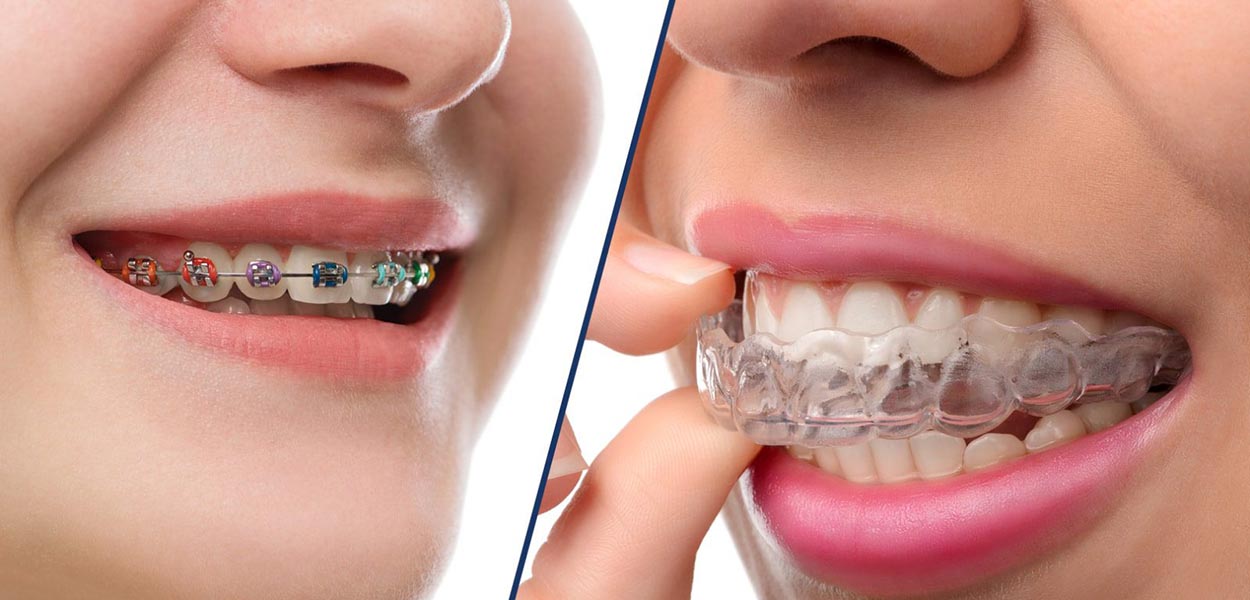Invisalign vs. Standard Dental braces: Which Option Is Right for You?
When thinking about orthodontic treatment, the choice in between Invisalign and typical dental braces provides numerous important factors that warrant cautious examination. Invisalign uses a discreet choice with detachable aligners, while standard braces offer a more noticeable yet efficient remedy for extreme misalignment.
Summary of Treatment Alternatives

On the other hand, typical braces are composed of steel brackets and cables that are adhered to the teeth. This method uses constant stress over time to achieve positioning. While reliable for complex orthodontic issues, typical braces need routine check outs for changes and can posture challenges in preserving dental health as a result of the difficulty of cleaning around wires and braces.
Both options have their advantages, and the option usually rests on particular dental conditions, way of life preferences, and client compliance. Ultimately, consulting an orthodontic professional is important for identifying one of the most suitable treatment strategy tailored to private demands. Understanding the nuances of each alternative can significantly influence the overall success of orthodontic therapy.
Aesthetic Factors To Consider
A substantial aspect influencing the selection in between Invisalign and typical dental braces is the aesthetic appeal each treatment provides. Invisalign aligners are crafted from clear plastic, making them virtually unnoticeable when put on.
On the other hand, traditional braces are composed of metal braces and wires, which can be extra visible. While developments in orthodontic technology have led to the advancement of smaller sized brackets and tinted elastics, conventional dental braces still preserve a more noticeable account. For some individuals, the presence of braces may hinder them from looking for essential treatment.
Inevitably, the choice between Invisalign and typical braces might depend upon personal choices concerning aesthetic appeals. Clients that focus on discretion usually lean toward Invisalign, while those who are much less worried regarding presence might go with typical braces. Comprehending the visual effects of each choice is crucial for making a notified decision that aligns with one's way of living and preferences.
Convenience and Convenience

In regards to convenience, Invisalign aligners are removable, making it possible for people to appreciate their favored foods without restriction and preserve ideal oral health. Brushing and flossing are simplified, as the aligners can be gotten throughout these regimens, whereas standard braces need careful navigating around cords and brackets.
In contrast, conventional braces require routine modifications, making them much less convenient for those with click reference busy routines. Overall, the comfort and ease of Invisalign make it an enticing choice for numerous individuals seeking orthodontic therapy.
Treatment Duration and Efficiency
While both Invisalign and conventional braces are effective in remedying oral imbalances, the duration of therapy can differ dramatically between the 2 choices. Typically, Invisalign treatment can take anywhere from 12 to 18 months, depending on the complexity of the case. The clear aligners work by slowly moving teeth right into their preferred settings, and routine follow-ups with an orthodontist aid ensure progression remains on the right track.
In comparison, standard braces often need a longer dedication, normally varying from 18 months to 3 years. This is due to their fixed nature and the usage of cords and braces, which can be a lot more efficient for intricate situations and severe imbalances (Invisalign). The therapy effectiveness of conventional dental braces is well-documented, as they permit exact changes and higher control over tooth movement
Eventually, the selection between Invisalign and conventional dental braces might rest on both the anticipated treatment period and the particular dental concerns at hand. Consulting with an orthodontist is vital, as they can supply customized recommendations based upon individual requirements, guaranteeing the chosen technique straightens with preferred This Site durations and outcomes.
Expense Contrast and Insurance Coverage Choices
Price plays a significant duty in the decision-making process for people thinking about orthodontic treatment, whether selecting Invisalign or typical dental braces. Typically, the price of Invisalign arrays from $3,000 to $8,000, while conventional dental braces generally cost in between $2,000 and $6,000. Factors affecting these costs include the complexity of the situation, the period of therapy, and geographical place.
Insurance policy insurance coverage can considerably influence out-of-pocket expenditures. Numerous dental insurance plans give partial insurance coverage for orthodontic therapies, however the specifics can differ widely. It is essential for clients to review their insurance coverage to figure out the degree of protection for either choice. Generally, typical braces might be much more often covered by insurance strategies contrasted to Invisalign, which some insurance firms classify as an aesthetic procedure.
In addition, several orthodontic practices supply adaptable payment plans, making both treatment options much more obtainable. Clients ought to ask about potential financing options and discount rates for in advance payments. Examining the total cost, consisting of insurance coverage advantages and layaway plan, is necessary for making an informed decision that straightens with both aesthetic choices and spending plan factors to consider.

Conclusion
In recap, the selection in between Invisalign and conventional braces depends upon multiple factors, including visual preferences, comfort, treatment duration, and price. Invisalign uses a very discreet, removable alternative that promotes dental health and nutritional flexibility, while typical braces may be extra suitable for complicated dental issues and often come with a reduced rate factor. Inevitably, examination with an orthodontist is crucial basics to analyze specific situations and determine the most proper therapy option for achieving optimal dental positioning.
When thinking about orthodontic therapy, the option in between Invisalign and typical braces provides a number of important factors that merit mindful evaluation.Contrasting Invisalign and traditional braces discloses distinctive treatment alternatives for orthodontic modification.While both Invisalign and typical braces are efficient in dealing with dental misalignments, the duration of treatment can vary significantly between the two alternatives.Expense plays a considerable function in the decision-making procedure for individuals thinking about orthodontic therapy, whether opting for Invisalign or typical dental braces.In recap, the choice in between Invisalign and conventional braces hinges on several elements, consisting of visual choices, convenience, therapy duration, and price.